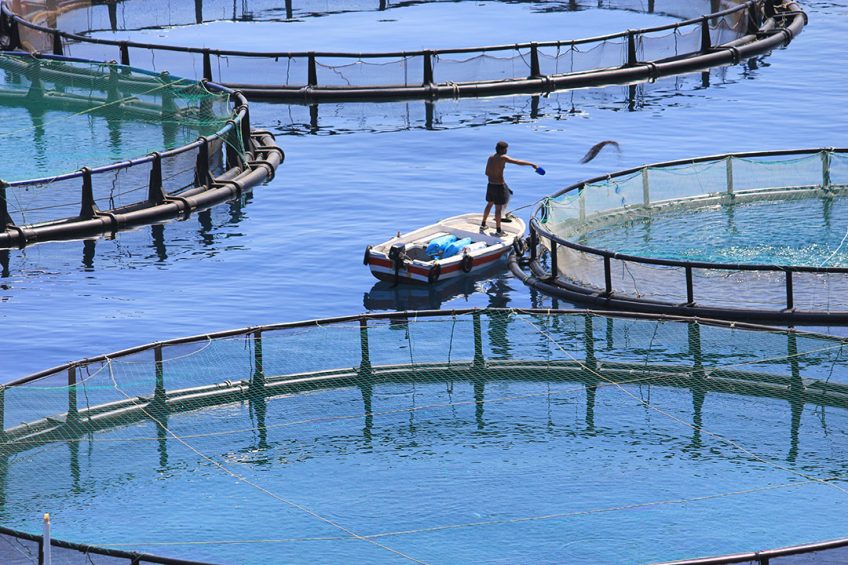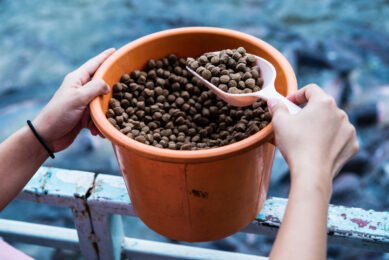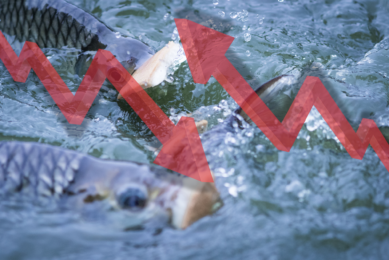The aquafeed market: Growth, trends and future outlook

As populations grow and pressure on wild fisheries mounts around the world, aquaculture is gaining attention – and a bigger share of the human food protein market. Demand for aquafeed is therefore also growing.
Global demand for seafood is projected to increase by 7 – 9% per year, according to Canada’s Blue Economy Strategy 2040, a joint plan created by the Canadian Aquaculture Industry Alliance and Fisheries Council of Canada. And while the authors note that “the sustainability of many global wild stocks is improving due to concerted efforts, future growth in demand is expected to be largely met by aquaculture. Today about half of all global seafood production for human consumption is farmed, and this is expected to rise to over 60% by 2030.”
Consumer perception of seafood
Part of the growth in demand for fish and other seafoods is due to consumer perceptions of these products as sustainable and healthy. They are low in fat and high in protein, many with high Omega fatty acid and vitamin content as well. And, on the environmental front, seafood farming is among the lowest in carbon emissions compared to all other types of livestock.
Aquafeed market growth
The most-farmed fish around the world are catfish, tilapia, Atlantic salmon, flatfish, trout, seabass, tuna and cod, but other types of farmed species include mussels, oysters, shrimp and eels. In tandem with the growth in seafood production, the aquafeed market is also expected to grow. According to a new report from GM insights, aquafeed is expected to achieve a 4.1% compound annual growth rate (CAGR) this year and each year up to 2026 globally.
Types of feed
Aquafeed, similarly to feed for other livestock groups such as pigs, comes in grower, finisher and brooder forms. It is also divided into wet, moist and dry forms. According to Grandview research, dry feed accounted for more than 36% of the global market in 2019. Dry feed is easy to manufacture in various pellet sizes. It’s also easy to store and transport. Wet feeds are made from fishery/slaughterhouse waste and are highly palatable. They are fed to carnivorous species such as sea bass and eels and must be handled carefully to avoid spoilage. Moist aquafeed combines wet and dry ingredients, and, while it’s more palatable than dry forms of feed, it must also be stored and transported carefully.
Main ingredients
According to Grandview, meal made from crops such as soybean, cottonseed and canola accounted for almost 40% of global aquafeed ingredient revenue in 2019. Incorporation of other grains such as rice, wheat, rapeseed and maize are also expected to strengthen the nutritional profile of various feed formulas.
Animal-based meal made from fish, squid and other seafood is also used in aquafeed, but their use is declining (see below). Other feed components include oils/fats, additives, feed acidifiers, vitamins, anti-parasitics and preservatives.
Below are some of the most important current global aquafeed trends:
Sustainable ingredients
The use of fishmeal and fish oil in aquaculture diets is still currently significant, particularly for feeding farmed salmonid species. The Institute of Food Technologists notes that currently 70% of the world’s fish oil supply goes into aquafeed formulations. However, the use of both animal-based oil and meal in farmed seafood is expected to diminish in the coming years. Its use is not sustainable as the aquaculture industry continues to expand, while pressure on wild fisheries increases along with human population level.
Limited supply for oil for aqua-industry
And, while the supply of fish oil and meal from wild stocks is limited, the supply of oil and meal from terrestrial crops available to the global aqua-industry is also limited. In addition, although soybean meal is protein and oil-rich, it is not considered by many to be a sustainable aquaculture ingredient source, because soybean production is having a very negative environmental impact in parts of the world such as Brazil.
Microalgae and macroalgae: Alternative sources of oil
More companies are therefore beginning to produce oil from alternative sources such as microalgae, including ADM in Chicago and Corbion in the Netherlands. In addition, in a May 2020 article in the journal Nature, researchers from Tasmania, California and Monaco explain that in addition to using microalgae and macroalgae for oil in aquafeed, using bacteria, yeast and insects will also be key to supplying future demand. “However,” they state, “considerable uncertainties remain surrounding novel feed efficacy across different life-cycle stages and taxa, and various social, environmental, economic and regulatory challenges will dictate their widespread use.” For its part, the National Oceanic and Atmospheric Administration in the US adds that “the economics of using blended oils is improving as fish oil prices rise and the technology to produce algae, and other replacement ingredients, improves.”
Role of genetics
Genetics will also play a role in making the switch from animal-based oil and meal aquafeed ingredients. Exciting results from a team of researchers at the University of Idaho US have recently been announced on this front, although the research continues. Several years ago, a selected strain of trout was developed by Dr Ken Overturf at the US Department of Agriculture Agricultural Research Service in Hagerman, Idaho with collaboration of University of Idaho. This strain can tolerate diets containing zero amounts of marine-based protein ingredients (100% plant protein-based diet). Dr Vikas Kumar at the Aquaculture Research Institute of the University of Idaho in collaboration with Dr Overturf has done further selection for feed-efficient trout. They were able to identify that some of the individuals in the selected strain of trout had feed efficiencies 10 to 15% higher than others.
Narrowing down formulations
As more information is learned about aquafeed ingredients and the nutrient requirements of various aquaculture species, diet formulations are becoming much more sophisticated, explains Rick Barrow, an aquaculture industry consultant and retired US Department of Agriculture fish nutritionist.
Various additives have now been found that improve fish well-being by boosting the immune response and reducing stress. In a recent article in Veterinaria Digital, Dr Ekaitz Maguregui notes that feeding ‘immunostimulant pronutrients’ promotes the activity of immune system macrophages and neutrophils. “Improving the fish immune system has a direct effect on the productive parameters, because they are more prepared to fight infections and, thus, avoid their negative effect on growth and feed utilisation,” states Maguregui. “The use of immunostimulant pronutrients makes it possible to improve feed conversion rates by 31% and increase weight gain by 61%, thanks to their direct effect on the immune system.”
In Europe alone, the aquafeed additives market is undergoing an upsurge and is expected by 2026 to reach US$ 285 million (CAGR of 4.8%), according to GM insights. This is due to increased production of species such as rainbow trout, Atlantic salmon, seabass and sea breams in countries that include Norway, Greece, Scotland and Spain.
Prices
According to Grandview research, the aquafeed industry will continue to be faced with the challenges of fluctuations in the prices of ingredients such as maize and soybean and fishmeal, due to factors such as fluctuating oil prices and currencies, adverse weather conditions, ingredient availability, and more.
In terms of new ingredients such as oil from microalgae, Barrows notes that “nutritional and economic value are the two measurements, and cost is always a factor, but the cost of these ingredient continues to decline as they scale up, and the costs of fishmeal and oil continue to climb, in general.”
Outlook very strong
As had occurred with other livestock feeds over time, aquafeeds will become more sustainable, specific, palatable, digestible and nutritious. In addition, automated feeding systems will result in better species performance and less feed waste.











